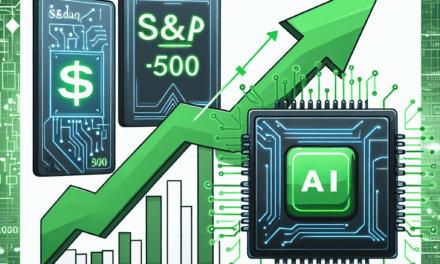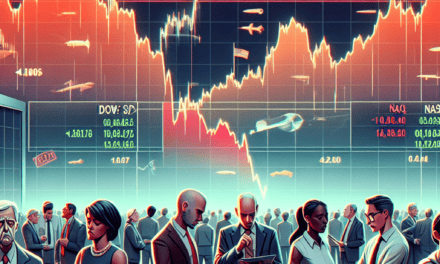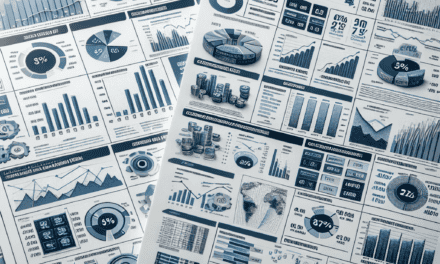“Rising Tensions: Navigating the Final Hurdles in US Inflation Reduction”
Introduction
In the final stages of the United States’ efforts to curb inflation, the challenges have become increasingly complex and multifaceted. As policymakers and economic strategists navigate this critical phase, they face a confluence of factors that threaten to undermine the progress made thus far. Supply chain disruptions, fluctuating energy prices, and geopolitical tensions are exerting upward pressure on costs, complicating the Federal Reserve’s monetary policy decisions. Additionally, the labor market’s uneven recovery and persistent wage growth are contributing to inflationary pressures, while consumer demand remains robust. These dynamics create a precarious environment where the risk of stagflation looms, necessitating a delicate balance between tightening monetary policy and supporting economic growth. As the nation grapples with these intensified challenges, the path to sustainable inflation reduction remains fraught with uncertainty and requires coordinated efforts across fiscal and monetary domains.
Economic Impacts of Inflation Reduction on American Households
As the United States approaches the final stages of its inflation reduction efforts, the economic impacts on American households have become increasingly pronounced. The journey to curb inflation has been fraught with challenges, and while some progress has been made, the path forward remains complex. Initially, the Federal Reserve’s aggressive interest rate hikes were aimed at cooling down an overheated economy. These measures, while necessary, have had a ripple effect on various aspects of household finances, creating a mixed bag of outcomes for American families.
To begin with, the most immediate impact of inflation reduction efforts has been felt in the housing market. Higher interest rates have led to increased mortgage costs, making homeownership less affordable for many. Consequently, potential homebuyers are finding it more difficult to enter the market, while existing homeowners with variable-rate mortgages are facing higher monthly payments. This situation has forced some families to reconsider their housing options, potentially delaying plans to purchase a home or even downsizing to manage costs more effectively.
Moreover, the cost of borrowing has risen across the board, affecting everything from auto loans to credit card debt. As interest rates climb, the cost of financing large purchases has become more burdensome, leading households to reassess their spending habits. This shift in consumer behavior has had a dampening effect on economic growth, as reduced spending translates to lower demand for goods and services. Businesses, in turn, may experience decreased revenues, which can lead to cutbacks in hiring or investment, further impacting household incomes.
In addition to these challenges, the labor market has also been influenced by inflation reduction policies. While unemployment rates have remained relatively low, wage growth has not kept pace with inflation, eroding purchasing power for many workers. This disparity has led to increased financial strain on households, particularly those with fixed or lower incomes. As a result, families are finding it more difficult to maintain their standard of living, with some resorting to savings or credit to bridge the gap between income and expenses.
Despite these hurdles, there are some positive developments on the horizon. For instance, as inflationary pressures begin to ease, the cost of essential goods and services is expected to stabilize. This stabilization could provide much-needed relief to households struggling with rising prices. Additionally, the Federal Reserve’s efforts to manage inflation are aimed at creating a more sustainable economic environment in the long term, which could ultimately benefit American families by fostering stable growth and employment opportunities.
Furthermore, the government’s focus on inflation reduction has spurred discussions on the need for structural reforms to address underlying economic vulnerabilities. These conversations have highlighted the importance of investing in infrastructure, education, and healthcare to build a more resilient economy. By addressing these foundational issues, policymakers hope to create a more equitable economic landscape that can better withstand future shocks.
In conclusion, while the final stages of US inflation reduction present significant challenges for American households, they also offer opportunities for positive change. The road ahead will require careful navigation and a balanced approach to ensure that the benefits of reduced inflation are realized without exacerbating existing economic disparities. As policymakers continue to refine their strategies, the ultimate goal remains clear: to create a stable and prosperous economic environment that supports the well-being of all American families.
Policy Adjustments in Response to Inflationary Pressures
As the United States navigates the final stages of its inflation reduction efforts, policymakers are confronted with a complex array of challenges that necessitate careful adjustments to existing policies. The journey to curtail inflation has been arduous, marked by a series of strategic interventions aimed at stabilizing the economy. However, as inflationary pressures persist, the need for nuanced policy adjustments becomes increasingly apparent. This phase of economic management requires a delicate balance between fostering growth and ensuring price stability, a task that demands both precision and foresight.
Initially, the Federal Reserve’s approach to combating inflation involved a series of interest rate hikes designed to temper consumer spending and curb demand. While these measures have yielded some success in slowing inflation, they have also introduced new challenges. Higher interest rates have led to increased borrowing costs, which in turn have impacted both businesses and consumers. Consequently, there is a growing concern about the potential for these measures to stifle economic growth, particularly as businesses face higher costs for capital and consumers grapple with more expensive loans.
In response to these concerns, policymakers are exploring alternative strategies to mitigate inflation without unduly hindering economic expansion. One such approach involves targeted fiscal policies aimed at addressing specific sectors that are contributing to inflationary pressures. For instance, supply chain disruptions have been a significant driver of price increases, and efforts to alleviate these bottlenecks could help stabilize prices. By investing in infrastructure improvements and incentivizing domestic production, the government hopes to enhance supply chain resilience and reduce dependency on volatile global markets.
Moreover, the labor market presents another area where policy adjustments are crucial. The pandemic-induced labor shortages have contributed to wage inflation, further exacerbating overall price increases. To address this, there is a concerted effort to enhance workforce participation through initiatives such as skills training programs and childcare support. By increasing the labor supply, policymakers aim to ease wage pressures and contribute to a more balanced economic environment.
In addition to these domestic measures, international considerations also play a pivotal role in shaping policy responses. Global economic conditions, including fluctuating commodity prices and geopolitical tensions, continue to influence inflationary trends in the United States. As such, maintaining open lines of communication with international partners and engaging in multilateral efforts to stabilize global markets are essential components of the broader strategy to manage inflation.
Furthermore, the importance of clear communication from policymakers cannot be overstated. As the Federal Reserve and other government entities navigate these complex challenges, transparency in their decision-making processes is vital to maintaining public confidence. By clearly articulating the rationale behind policy adjustments and setting realistic expectations, policymakers can help mitigate uncertainty and foster a more stable economic environment.
In conclusion, the final stages of the United States’ inflation reduction efforts are characterized by a series of intricate challenges that require thoughtful policy adjustments. Balancing the need for economic growth with the imperative of price stability demands a multifaceted approach that addresses both domestic and international factors. Through targeted fiscal policies, labor market interventions, and effective communication, policymakers aim to navigate these challenges and guide the economy toward a more stable and prosperous future. As these efforts continue, the lessons learned from this period will undoubtedly inform future economic strategies, ensuring that the United States remains resilient in the face of evolving economic landscapes.
The Role of Federal Reserve in Managing Inflation
As the United States navigates the final stages of its inflation reduction efforts, the role of the Federal Reserve becomes increasingly pivotal. The Federal Reserve, often referred to as the Fed, is tasked with the dual mandate of promoting maximum employment and ensuring price stability. In recent years, these objectives have been challenged by fluctuating economic conditions, necessitating a nuanced approach to monetary policy. The complexities of managing inflation are compounded by external factors such as global supply chain disruptions and geopolitical tensions, which have contributed to price volatility across various sectors.
To address these challenges, the Federal Reserve employs a range of tools, with interest rate adjustments being one of the most prominent. By raising or lowering the federal funds rate, the Fed influences borrowing costs, consumer spending, and ultimately, inflation. In periods of high inflation, increasing interest rates can help cool an overheated economy by making borrowing more expensive, thereby reducing spending and slowing down price increases. However, this approach is not without its risks. Higher interest rates can also dampen economic growth and lead to increased unemployment, creating a delicate balancing act for policymakers.
Moreover, the Federal Reserve’s communication strategy plays a crucial role in managing inflation expectations. By providing clear guidance on future policy actions, the Fed aims to anchor public expectations and prevent inflationary or deflationary spirals. This transparency is vital, as it helps businesses and consumers make informed decisions about spending and investment. However, the challenge lies in maintaining credibility while navigating an unpredictable economic landscape. Any perceived missteps or inconsistencies in communication can lead to market volatility and undermine the Fed’s efforts to stabilize prices.
In addition to domestic considerations, the Federal Reserve must also account for international economic dynamics. The interconnectedness of global markets means that inflationary pressures in one region can quickly spill over into others. For instance, supply chain disruptions in Asia or energy price fluctuations in Europe can have significant repercussions for the US economy. Consequently, the Fed must remain vigilant and adaptable, ready to adjust its policies in response to global developments. This requires a comprehensive understanding of international economic trends and a willingness to collaborate with other central banks to address shared challenges.
Furthermore, the Federal Reserve’s role in managing inflation is influenced by fiscal policy decisions made by the federal government. While the Fed focuses on monetary policy, fiscal measures such as government spending and taxation also impact inflation. Coordination between monetary and fiscal authorities is essential to ensure that policies are complementary and not working at cross-purposes. For example, expansive fiscal policies aimed at stimulating growth could counteract the Fed’s efforts to curb inflation, necessitating careful alignment of strategies.
As the US approaches the culmination of its inflation reduction efforts, the Federal Reserve faces intensified challenges that require a multifaceted approach. Balancing interest rate adjustments, managing public expectations, and navigating international economic dynamics are all critical components of this endeavor. Additionally, effective coordination with fiscal authorities is paramount to achieving the desired outcomes. In this complex environment, the Federal Reserve’s ability to adapt and respond to evolving conditions will be crucial in ensuring long-term economic stability and prosperity.
Supply Chain Disruptions and Their Effect on Inflation
As the United States approaches the final stages of its inflation reduction efforts, the complexities of supply chain disruptions continue to pose significant challenges. These disruptions, which have been a persistent issue since the onset of the COVID-19 pandemic, have exacerbated inflationary pressures, complicating the Federal Reserve’s task of stabilizing prices. Understanding the intricate relationship between supply chain disruptions and inflation is crucial for policymakers and businesses alike as they navigate this turbulent economic landscape.
To begin with, supply chain disruptions have led to shortages of key goods and materials, driving up prices across various sectors. For instance, the semiconductor shortage has severely impacted the automotive and electronics industries, resulting in higher costs for consumers. Similarly, disruptions in the global shipping industry have led to increased freight costs, which are often passed on to consumers in the form of higher prices for goods. These factors contribute to a broader inflationary environment, making it more challenging for the Federal Reserve to achieve its inflation targets.
Moreover, the labor market has also been affected by supply chain issues, further complicating inflation reduction efforts. Labor shortages in critical sectors such as transportation and logistics have led to increased wages, which, while beneficial for workers, add to the cost pressures faced by businesses. As companies struggle to maintain profitability, they may be forced to raise prices, thereby fueling inflation. This creates a feedback loop where supply chain disruptions lead to higher wages, which in turn contribute to rising prices, making it difficult to break the cycle of inflation.
In addition to these direct effects, supply chain disruptions have also led to increased uncertainty in the market. Businesses are finding it challenging to plan for the future due to unpredictable supply chain conditions, leading to cautious investment and production decisions. This uncertainty can dampen economic growth, as companies may delay expansion plans or reduce output in response to supply chain volatility. Consequently, this can have a ripple effect on inflation, as reduced supply can lead to higher prices, further complicating efforts to stabilize the economy.
Furthermore, geopolitical tensions and trade policies have added another layer of complexity to supply chain disruptions. Tariffs and trade restrictions can exacerbate supply chain issues by limiting access to essential goods and materials. For example, ongoing trade disputes between major economies can disrupt the flow of goods, leading to shortages and price increases. These geopolitical factors can create additional inflationary pressures, making it even more challenging for policymakers to address the root causes of inflation.
In response to these challenges, businesses and policymakers must adopt a multifaceted approach to mitigate the impact of supply chain disruptions on inflation. This includes investing in supply chain resilience, diversifying sources of supply, and leveraging technology to improve efficiency. Additionally, policymakers must work collaboratively with international partners to address trade barriers and promote a more stable global trading environment. By taking these steps, it is possible to alleviate some of the pressures on supply chains and, in turn, help reduce inflationary pressures.
In conclusion, as the United States endeavors to bring inflation under control, the persistent issue of supply chain disruptions remains a formidable obstacle. The interplay between supply chain challenges and inflation underscores the need for comprehensive strategies that address both immediate and long-term concerns. By understanding and addressing these complexities, policymakers and businesses can work towards a more stable economic environment, ultimately facilitating the successful reduction of inflation.
Energy Prices and Their Influence on Inflation Trends
As the United States approaches the final stages of its inflation reduction efforts, the role of energy prices has become increasingly significant. Energy costs, particularly those related to oil and natural gas, have long been a critical component of the broader inflationary landscape. In recent months, fluctuations in these prices have posed substantial challenges to policymakers striving to stabilize the economy. Understanding the intricate relationship between energy prices and inflation trends is essential for comprehending the complexities of the current economic environment.
To begin with, energy prices directly impact the cost of living and production. When energy prices rise, the cost of transportation, manufacturing, and heating increases, leading to higher prices for goods and services. This, in turn, contributes to overall inflation. Conversely, when energy prices fall, there is often a corresponding decrease in inflationary pressures. However, the relationship is not always straightforward, as other factors such as supply chain disruptions and geopolitical tensions can exacerbate or mitigate these effects.
In recent years, the global energy market has experienced significant volatility, influenced by a myriad of factors including geopolitical conflicts, natural disasters, and shifts in energy policy. For instance, tensions in oil-producing regions can lead to supply disruptions, causing prices to spike. Similarly, natural disasters such as hurricanes can damage infrastructure and reduce supply, further driving up costs. These events highlight the vulnerability of the energy market to external shocks, which can have cascading effects on inflation.
Moreover, the transition towards renewable energy sources adds another layer of complexity to the inflationary equation. While the shift to renewables is essential for long-term sustainability, it requires substantial investment and infrastructure development. In the short term, these costs can contribute to inflationary pressures as economies adjust to new energy paradigms. However, over time, the increased use of renewables is expected to stabilize energy prices and reduce inflationary volatility.
In addition to these factors, government policies play a crucial role in shaping energy prices and their impact on inflation. Subsidies, taxes, and regulations can all influence the cost of energy. For example, subsidies for renewable energy can lower costs and encourage adoption, while taxes on carbon emissions can increase prices and deter consumption. Policymakers must carefully balance these measures to achieve their inflation reduction goals without stifling economic growth.
Furthermore, consumer behavior and expectations also influence the relationship between energy prices and inflation. When consumers anticipate rising energy costs, they may alter their spending habits, leading to changes in demand and price levels. Similarly, businesses may adjust their pricing strategies in response to expected changes in energy costs, further influencing inflation trends. Understanding these behavioral dynamics is crucial for policymakers as they navigate the final stages of inflation reduction.
In conclusion, the interplay between energy prices and inflation is a complex and multifaceted issue that requires careful consideration by policymakers. As the United States seeks to reduce inflation, addressing the challenges posed by volatile energy prices is paramount. By understanding the various factors that influence energy costs and their impact on inflation, policymakers can develop strategies that promote economic stability and growth. As the nation moves forward, the ability to adapt to changing energy landscapes will be essential in achieving long-term inflation reduction goals.
Labor Market Dynamics Amid Inflation Reduction Efforts
As the United States navigates the final stages of its inflation reduction efforts, the labor market dynamics present a complex landscape that policymakers must carefully manage. The interplay between inflation control measures and labor market conditions is intricate, with each influencing the other in significant ways. Understanding these dynamics is crucial for ensuring a balanced approach that mitigates inflation without stifling economic growth or exacerbating unemployment.
To begin with, the Federal Reserve’s monetary policy plays a pivotal role in shaping labor market outcomes during inflation reduction efforts. By adjusting interest rates, the Fed aims to control inflationary pressures while maintaining economic stability. However, higher interest rates can lead to increased borrowing costs for businesses, potentially slowing down investment and hiring. This delicate balance requires careful calibration to avoid triggering a recession, which could lead to job losses and increased unemployment.
Moreover, the labor market itself is undergoing significant changes that complicate the inflation reduction process. The COVID-19 pandemic has accelerated shifts in work patterns, with remote work becoming more prevalent and certain sectors experiencing labor shortages. These changes have led to wage pressures in some industries, contributing to inflationary trends. As businesses compete for a limited pool of workers, they may offer higher wages, which can, in turn, lead to increased consumer spending and further inflationary pressures.
In addition to these challenges, demographic shifts are also influencing labor market dynamics. An aging population and declining birth rates are contributing to a shrinking workforce, which can exacerbate labor shortages and wage pressures. This demographic trend underscores the importance of policies that encourage labor force participation, such as retraining programs and incentives for older workers to remain in the workforce.
Furthermore, globalization and technological advancements continue to reshape the labor market landscape. While these forces have historically contributed to economic growth and efficiency, they also present challenges in the context of inflation reduction. Global supply chain disruptions, for instance, have led to increased costs for goods and services, complicating efforts to control inflation. At the same time, technological advancements are transforming industries, leading to shifts in labor demand and the need for workers to acquire new skills.
In light of these complexities, policymakers must adopt a multifaceted approach to managing labor market dynamics amid inflation reduction efforts. This includes not only monetary policy adjustments but also targeted fiscal policies that support workforce development and address structural challenges. For example, investments in education and training programs can help workers adapt to changing labor market demands, while policies that promote innovation and productivity can enhance economic resilience.
Moreover, collaboration between government, businesses, and labor organizations is essential to ensure that inflation reduction efforts do not disproportionately impact vulnerable populations. By fostering dialogue and cooperation, stakeholders can develop strategies that balance inflation control with economic growth and job creation.
In conclusion, the final stages of US inflation reduction efforts present a complex interplay of labor market dynamics that require careful management. By understanding the intricate relationships between monetary policy, demographic trends, globalization, and technological advancements, policymakers can navigate these challenges effectively. Through a balanced and collaborative approach, it is possible to achieve inflation control while fostering a resilient and inclusive labor market that supports long-term economic prosperity.
Long-term Strategies for Sustaining Low Inflation Rates
As the United States approaches the final stages of its inflation reduction efforts, the challenges associated with sustaining low inflation rates have become increasingly complex. The initial phases of inflation control often involve aggressive monetary policies, such as interest rate hikes and quantitative tightening, which can yield relatively quick results. However, as these measures take effect, the focus must shift towards long-term strategies that ensure inflation remains at manageable levels without stifling economic growth. This delicate balance requires a multifaceted approach, incorporating both fiscal and monetary policies, as well as structural reforms.
One of the primary challenges in maintaining low inflation is the inherent unpredictability of global economic conditions. External factors, such as geopolitical tensions, supply chain disruptions, and fluctuating commodity prices, can all exert upward pressure on inflation. To mitigate these risks, policymakers must adopt a proactive stance, closely monitoring global trends and adjusting domestic policies accordingly. This may involve diversifying trade partnerships, investing in domestic production capabilities, and enhancing energy independence to reduce vulnerability to external shocks.
Moreover, the labor market plays a crucial role in the inflationary landscape. As the economy recovers and unemployment rates decline, wage pressures can emerge, potentially leading to a wage-price spiral. To address this, it is essential to focus on increasing labor productivity through investments in education, training, and technology. By equipping the workforce with the necessary skills and tools, productivity gains can offset wage increases, thereby preventing inflationary pressures from escalating.
In addition to these economic factors, demographic trends also influence inflation dynamics. An aging population, for instance, can lead to a shrinking labor force and increased demand for healthcare services, both of which can contribute to inflation. Policymakers must therefore consider demographic shifts in their long-term strategies, potentially by encouraging higher labor force participation rates among underrepresented groups or by implementing policies that support family growth and immigration.
Furthermore, fiscal policy plays a pivotal role in sustaining low inflation rates. While monetary policy is often the primary tool for controlling inflation, fiscal measures such as prudent government spending and efficient tax systems can complement these efforts. By maintaining a balanced budget and reducing public debt, governments can create a stable economic environment that fosters confidence among investors and consumers alike. This, in turn, can help anchor inflation expectations and prevent inflationary spirals.
Another critical aspect of long-term inflation management is the role of central banks. Central banks must maintain their independence and credibility to effectively manage inflation expectations. Clear communication and transparency in policy decisions are essential to build trust and ensure that market participants understand the rationale behind monetary actions. This can help prevent overreactions and maintain stability in financial markets.
In conclusion, the final stages of US inflation reduction present a unique set of challenges that require a comprehensive and coordinated approach. By addressing external economic factors, enhancing labor productivity, considering demographic trends, implementing sound fiscal policies, and ensuring central bank credibility, policymakers can create a sustainable framework for maintaining low inflation rates. As these strategies are put into practice, the focus must remain on fostering an environment that supports economic growth while keeping inflation in check, ultimately ensuring long-term prosperity for the nation.
Q&A
1. **What are the main challenges in the final stages of US inflation reduction?**
– The main challenges include persistent supply chain disruptions, labor market tightness, and geopolitical tensions affecting energy prices.
2. **How does the labor market impact inflation reduction efforts?**
– A tight labor market can lead to wage increases, which may contribute to higher consumer prices and complicate efforts to reduce inflation.
3. **What role do supply chain issues play in inflation?**
– Supply chain disruptions can lead to shortages and increased costs for goods, thereby sustaining higher inflation levels.
4. **How are energy prices influencing inflation?**
– Fluctuations in energy prices, often driven by geopolitical factors, can directly impact transportation and production costs, thus affecting overall inflation.
5. **What monetary policy tools are being used to combat inflation?**
– The Federal Reserve may use interest rate hikes and quantitative tightening to reduce inflation by curbing demand.
6. **How does consumer behavior affect inflation reduction?**
– Increased consumer spending can drive demand-pull inflation, making it harder to reduce overall inflation levels.
7. **What external factors are complicating US inflation reduction efforts?**
– Global economic uncertainties, such as trade tensions and international conflicts, can exacerbate inflationary pressures by affecting import prices and supply chains.
Conclusion
In the final stages of the US Inflation Reduction efforts, several challenges have intensified, complicating the path to achieving stable economic conditions. Key issues include persistent supply chain disruptions, which continue to drive up costs and limit the availability of goods, thereby exerting upward pressure on prices. Additionally, labor market imbalances, characterized by worker shortages and wage inflation, further exacerbate inflationary pressures. The Federal Reserve’s monetary policy adjustments, aimed at curbing inflation, face the delicate task of balancing interest rate hikes without stifling economic growth. Moreover, geopolitical tensions and energy market volatility contribute to uncertainty, impacting both consumer and business confidence. These challenges underscore the complexity of managing inflation in a dynamic global environment, necessitating coordinated policy responses and adaptive strategies to ensure long-term economic stability.





